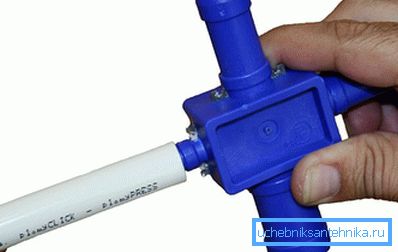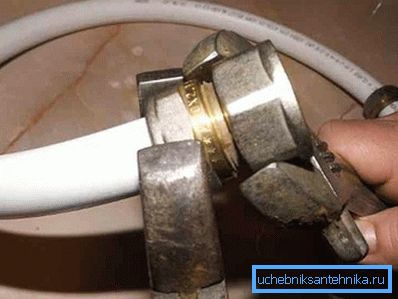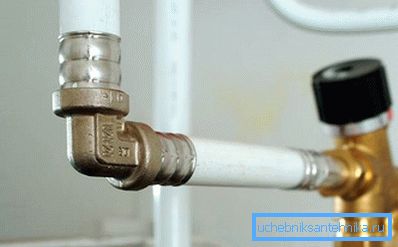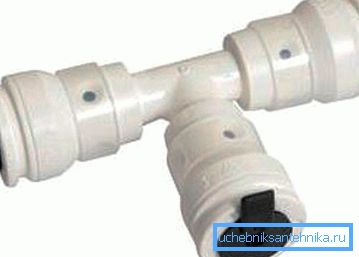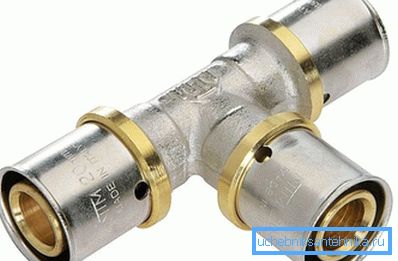Installation of metal pipes
Laying engineering systems in the house are often performed by the owners themselves. For installation, a material is chosen that is easily connected to a common pipeline. Metal pipes - a common option for creating a plumbing system in a private house or apartment. Thanks to the design features, they are flexible and durable, while at the same time retaining a given shape. In this article we will explain how to install metal-plastic pipes with your own hands.
Characteristics and properties
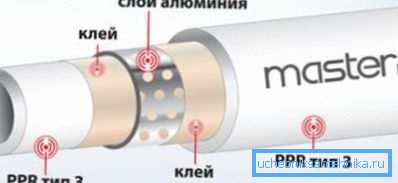
Metal-plastic pipes are distinguished by a successful combination of two materials in one design, their outer layer is made of durable protective polyethylene, the inner part is food-grade polyethylene, which ensures the safety of drinking water, and between the adhesive gaskets an aluminum layer is retained. The metal component is necessary to compensate for the expansion of plastic during heating and to give pipes strength. The design determined the properties and scope of use of products. Plumbing of metal pipes - the most popular version of their use, in addition, the material is suitable for heating and underfloor heating, it is installed in the kitchen and in the bathroom. Among the advantages of the product:
- High resistance to corrosion and chemical attack.
- Simplicity of installation and possibility of repair when connecting with a threaded fitting.
- No deposits inside the pipes.
- The ability to maintain a given shape.
- Affordable cost.
- Long service life.

The diameter of the products is 16–53 mm, but the most demanded pipes are O 16 and 20 mm, and the fittings themselves need the size to be cheaper than other sizes. Pipes are available in coils of considerable length, so you can cut any length. The working temperature of the pipes ranges from 0 to +95? C. When marking products, the manufacturer, nominal pressure and temperature, diameter and type of material are indicated. This information is enough to choose if it is not on the pipe, it means that you should not buy such a product.
Creating a pipe wiring diagram allows you to calculate their footage and number of fittings. It determines the place of fastening pipes to walls or cutting out gates for concealed wiring of the pipeline. You can mark the pipeline directly on the walls - this will facilitate the work.
Connection methods

Installation is possible in two ways:
- threaded compression fitting;
- press fitting (permanent connection).
The connection with a threaded fitting does not require any special tools; it can be disassembled and redone. Among the disadvantages are the high price of compression parts and the need to check and tighten the connection. Such a system can not be walling in the wall, and the body parts subject to corrosion and wear.
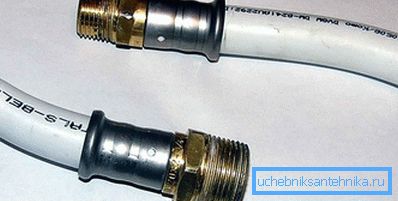
Press fitting connects pipes reliably and durable, most often used for installation of floor heating hidden wiring. The compound has no flaws, but requires a special press and some experience with this equipment.
Connection press fitting is not folding.
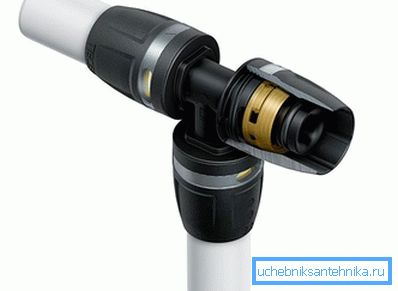
In addition to the considered methods, there is an alternative connection - push-fitting. This is a self-locking connection that does not require the use of equipment. Inside the case of a modern fitting, a coupling and a spring-loaded ring are installed, as well as sealing rings to prevent leakage. When mounting, it is necessary to insert the pipe into the push-fit all the way. To control the fixation of the pipe edge, there is a viewing window in the fitting coupling. The body of the product is shockproof, it is made of resistant polymer.
The compound is used for cold and hot water and serves 50 years. The material is environmentally friendly and safe for drinking water.
Tools for work

- Press pincers for one-piece connection.
- Sharp scissors for cutting metal pipes.
- Calibrator
- Spanners.
- Sanding paper and file.
- Tape measure and pencil.
- Spring for pipe bending.
Mounting technology

Installation of plastic pipes is carried out as follows:
- The required length of pipe is measured, taking into account the occurrence in the fitting and cut along the intended line. The cutting process is difficult because of the softness of the pipe and its tendency to warp. If the edge is set, it is aligned with a calibrator. The sharp edges of the pipe and the burrs are cleaned with a round file. If this is not done, they will damage the rubber gasket of the fitting and the tightness of the joint will be broken. The cutting of the pipe is done with special scissors, when using other tools, the cut is uneven, and the protective layer of the pipe can be damaged. In such a place may leak water.
- O-rings are located on the fitting fitting, and inside the rubber gasket - before connecting, make sure they are suitable. After inspection, a compression nut and ring, which is straight or tapered, is put on the edge of the pipe. The last option is put on the thin side to the nut.
- A calibrator is inserted into the edge of the pipe and rotated in different directions. This is necessary to increase the internal diameter, this process is called flaring. For a tight connection, the size of the fitting exceeds the cross section of the pipe.
- Having moistened the fitting, a pipe is pulled over it, the nut with the sealing ring is pushed in and tightened with a wrench. It is convenient to use two tools - one to hold the fitting, and the second to tighten the nut. It is tightened until the appearance of a characteristic crack, if you continue to twist, the metal will burst.
- For transition from a metalplastic pipe to metal the collet fitting is used. It also allows you to connect pipes of different diameters. Installation of sewer pipes is performed by compression fittings.
How to bend the pipe correctly

In contrast to plastic pipes, metal-plastic communications can be bent at the right angle, which saves the amount of expensive fitting, and the absence of joints eliminates leakage. To bend the pipe in several ways:
- Manually without the use of tools, this method is suitable for bending at a small angle up to 20 ?.
- After the bend is heated by the building dryer, the bend is performed with a simple movement. This method requires care, you can not overheat the plastic.
- With the help of a special spring that is inserted into the pipe, and allows you to easily and accurately bend the product. For each section, a suitable spring is selected.
- The special pipe bender, this tool will help the masters who have no experience. The algorithm of use is simple - the desired angle is set and a metal-plastic pipe is inserted into the device, while mixing the handles, bending is performed.
The bending of the pipe O16 mm (produced manually) must be such that the resulting distance between the pipes turned out to be not less than 80 mm.
Pipeline fastening to the wall
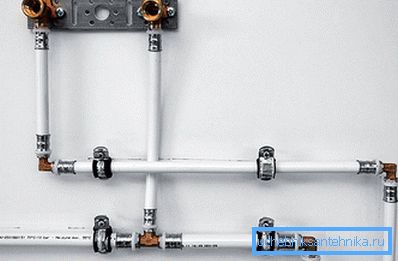
For fastening metal-plastic pipes use special clips, in which the product is simply inserted. They are made for different sections of pipes. Before installing the clips markup is performed, then the pipeline will lie flat. Fastening to the wall is done with screws or dowels, its pitch is 1 meter, thus avoiding sagging pipes. In the place where the pipeline is rotated, it is fixed on both sides.
Having considered all methods of installation, you can choose for yourself the most affordable and acceptable.
Video
This video will familiarize you with the basic rules for working with plastic pipes:
From this video you will learn how to bend a metal-plastic pipe without a special tool. Also in the video contains information about working with the conductor for MP pipes:
A photo

